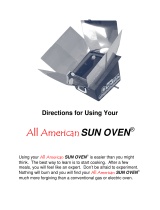
18
“Oven Fried” Chicken
Let’s say that you want to serve fried chicken in your food service operation but you don't want all of
the problems associated with a chicken program. You don't want to deal with an expensive breading
program, the high insurance costs, constantly buying oil, employee training, the dangerous
cleaning/filtering of French fryers, and the high cost of purchasing equipment. Cadco has the answer:
how about "Oven Fried" chicken. We take cooked, frozen, browned chicken and season it with the
seasoning(s) of your choice to produce the most delicious, unique chicken your customers have ever
tasted...and it's all done in your oven in about 30 minutes. Your chicken goes from the freezer, to the
oven, to the display case (and your customers) in less time than it takes to fry from raw.
We suggest Pierce Super Chicken; lay it out in a Cadco Oven Fry Basket (Model COB-F/Full Size),
and season the pieces with any seasoning of your choice. Then you simply bake it in the Cadco
Convection Oven at 325ºF for 20 minutes and it's ready to serve. You can have Cajun, Lemon Pepper,
Italian, TexMex, Smoky, Jamaican, or…Whatever flavor you want, “Oven Fried” Chicken!
“Rotisserie Style” Chicken
Tired of paying the grocery store to make those delicious rotisserie chickens for you? Once you make
your own “Rotisserie” chickens, in your Cadco Convection Oven, you’ll never buy another cooked
chicken from the store again (and I’ll bet your customers won’t either).
You’ll need a baking sheet pan and a cooking rack to keep your chicken elevated during the cooking
process. The cooking rack allows air to circulate all around the chicken, similar to a rotisserie. You
can also place your chicken directly on the oven rack and let it drip into a pan below.
Caution! Never allow grease to drip onto the bottom of the oven!
Method
Season a #3 chicken and place it on the cooking rack. (For options, see below)
Preheat your Convection Oven to 325ºF.
Roast the chicken for about 45 minutes. If a crispier product is desired, raise the temperature to about 350ºF.
Cook chicken to an internal temperature of 180ºF.
Stuffing the chicken will increase cooking time and it is NOT suggested.
Options
Slip slices of lemon under the skin on the breast before roasting.
Italian sausage under the skin of the breast before roasting.
Sun dried tomatoes, fresh herbs, under the skin before roasting.
Spray the chicken with olive oil, season, and dust with mashed potato flakes before roasting.
Save the chicken fat after roasting and chill it. Mix the fat, and a little stock, with left over shredded
chicken, and season with salt and pepper, to make a spread on slices of French bread. Needless to
say…this is NOT heart-healthy fare, but it sure is good.
Truss the chicken before roasting for more even cooking and eye appeal. Call for my quick method of
trussing a bird.
Burgers
Lay your ¼ pound frozen burgers out onto a sheet pan and season to taste. Place them into 350ºF oven
for about 10 to 12 minutes.
Hamburger should be cooked to an internal temperature of 165ºF to be safe according to HACCP
guidelines.
Try cooking your burgers at 250ºF for 15 to 20 minutes and notice how juicy they are. Browning is
not as pronounced using the low temperature method, but the added flavor makes up for it.





















